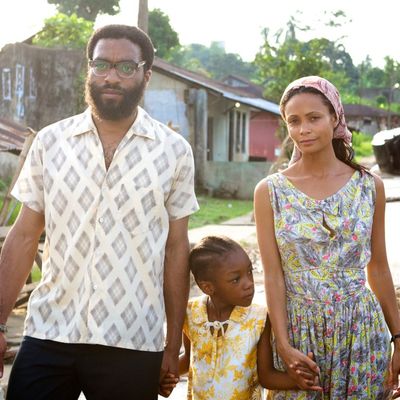
When it comes to turning books into film, the sprawling historical novel is both the most alluring and most treacherous of source material. Alluring because of the promise of sweep, atmosphere, and the spectacle of human lives jostled around by great events. Treacherous because, well, movies are short, and novels are long. Case in point: Half of a Yellow Sun, written and directed by the Nigerian-British author Biyi Bandele, and adapted from Chimamanda Ngozi AdichieÔÇÖs award-winning historical epic set during NigeriaÔÇÖs civil war in the 1960s, is transporting, well acted, and occasionally powerful. ItÔÇÖs also a rushed, maddening mess.
The film begins on the eve of Nigerian independence in 1960, and follows two young women, Olanna (Thandie Newton) and Kainene (Anika Noni Rose), the daughters of a wealthy Lagos businessman, as they pursue the privileges that beauty, family wealth, and their headstrong demeanors bring them. Kainene is cool, calculating, and has a head for business. Olanna, a sociologist, is madly in love with a revolutionary academic, Odenigbo (Chiwetel Ejiofor), even though his conservative, superstitious mother thinks sheÔÇÖs a witch. The powerful tension in these early scenes ÔÇö between the refined, aristocratic, ÔÇ£modernÔÇØ manners of our protagonists and the rough, rural beliefs and manners of the countryÔÇÖs underclass ÔÇö makes it clear that this current state of affairs cannot last. And it doesnÔÇÖt. The country is soon swept into ethnic strife and civil war, the breakaway Republic of Biafra is founded in the south, and we begin to realize that the petty worries and emotional lives of a group of well-educated nobodies become meaningless amid the great historical changes afoot.
The structure of Half of a Yellow Sun ÔÇö focusing on seemingly mundane and personal matters in its first half, epochal violence in its second ÔÇô has served everyone from Tolstoy to David O. Selznick well over the years. But thereÔÇÖs a lot of story to get through here, even in the early scenes. To give us historical context, Bandele occasionally cuts to news-reel footage from the period ÔÇö a tired device, perhaps, but a useful one here ÔÇö while sprinting from plot point to plot point, piling on the romantic duplicity and family strife without letting anybody breathe. The characters weÔÇÖre ostensibly watching feel as spectral as the generals and politicians who flit by in the black-and-white archival footage. As a result, the story line begins to take on the feel of a soap opera than anything involving real people; the emotions feel unearned. Even when the bombs start to fall and the death squads take over, weÔÇÖre left curiously cold.
Or rather, we would be left cold, if the cast wasnÔÇÖt so excellent. Ejiofor and Newton have obviously proven their chops elsewhere ÔÇö in films like 12 Years a Slave and Dirty Pretty Things and Beloved and Besieged ÔÇö but Bandele gets great performances from everybody up and down the line. John Boyega, who was in Attack the Block and is set to be one of the leads of the new Star Wars movie, also does wonders as OdenigboÔÇÖs servant-boy Ugwu, striking a perfect combination of loyalty and bewilderment. These are actors whoÔÇÖve proven their ability to go big countless times, and Half of a Yellow Sun, with its dramatic and sweeping story, offers them plenty of opportunities to do so. Which just makes the hurried, cursory nature of the storytelling that much more frustrating: ItÔÇÖs hard not to sense that somewhere amid all that footage is a great movie ÔÇö and probably a longer one ÔÇö aching to get out.


